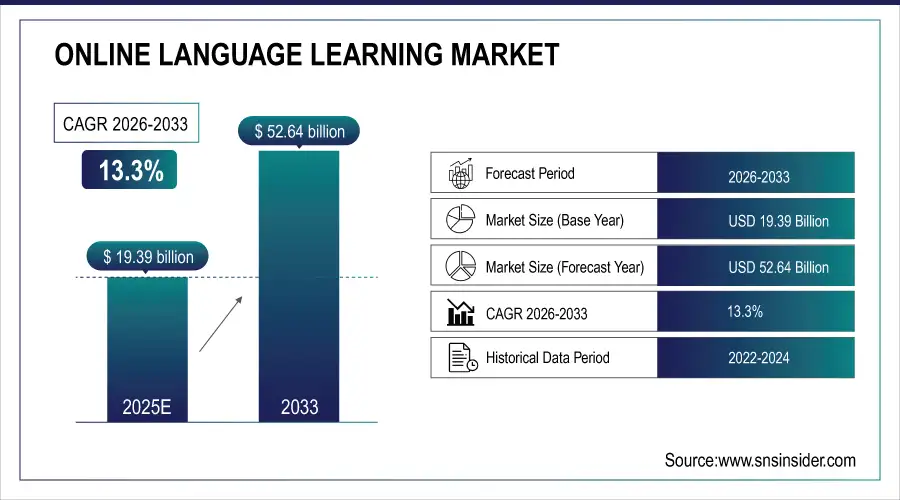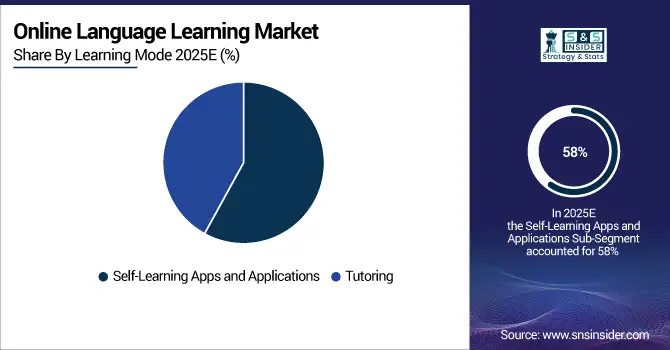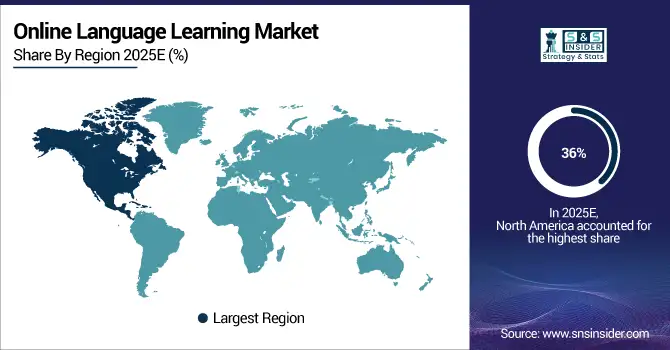Online Language Learning Market Report Scope & Overview:
The Online Language Learning Market Size was valued at USD 19.39 Billion in 2025E and is expected to reach USD 52.64 Billion by 2033, growing at a CAGR of 13.3% over the forecast period 2026-2033.
The online language learning market is rapidly growing due to globalization and rising multilingual demand. In the U.S., over 15% of jobs involve international trade, with 10% requiring multilingual skills, and 20% of households speak non-English languages. In Europe, 95% of secondary students learn a foreign language, while in Asia, over 300 million Chinese citizens study English, reflecting global educational trends.
Online Language Learning Market Size and Forecast:
-
Market Size in 2025E: USD 19.39 Billion
-
Market Size by 2033: USD 52.64 Billion
-
CAGR: 13.3% from 2026 to 2033
-
Base Year: 2025E
-
Forecast Period: 2026–2033
-
Historical Data: 2022–2024

Get more information on Online Language Learning Market - Request Free Sample Report
Online Language Learning Market Report Trends:
-
Rising demand for multilingual skills and globalization drives growth across education, corporate training, and personal learning.
-
Self-learning apps dominate the market due to accessibility, affordability, gamification, and flexible mobile-based learning.
-
AI-powered platforms enhance personalization, real-time conversation practice, and learner engagement, boosting adoption globally.
-
Government initiatives and digital education policies in regions like Asia-Pacific and Europe support online language learning expansion.
-
Smartphone penetration, high-speed internet, and affordable platforms accelerate adoption in developing markets.
-
Investment challenges and competition from free AI tools may affect funding and slow growth for smaller edtech providers.
The U.S. Online Language Learning market size was valued at an estimated USD 7.35 billion in 2025 and is projected to reach USD 20.10 billion by 2033, growing at a CAGR of 12.9% over the forecast period 2026–2033. Market growth is driven by increasing demand for flexible and personalized learning solutions, rising adoption of e-learning platforms across academic, corporate, and individual learners, and growing need for multilingual skills in a globalized workforce. Expanding use of AI-powered language learning apps, gamified content, and mobile-based platforms is accelerating market expansion. Additionally, increasing corporate training initiatives, integration of immersive technologies such as AR/VR, and strong investments in digital education further strengthen the growth outlook of the U.S. online language learning market during the forecast period.

Online Language Learning Market Drivers:
-
The rise of mobile-first applications and smartphone penetration, particularly in developing countries, has broadened the market by providing on-the-go learning solutions.
One of the key drivers for the online language learning market is the rapid growth of e-learning platforms. Digital technology’s advancement allows platforms like Duolingo, Babbel, Coursera, and others to offer online language learning solutions that are accessible, affordable, and flexible. Language learners can study at their own pace and from wherever in the world they are. These platforms offer interactive and stimulating methods, such as gamification and the option to book live tutoring sessions, to appeal to a wide range of people, including students, professionals, and those planning on traveling. For example, as of 2023, Duolingo boasts 74 million monthly active users, showing that a large number of people are currently using online language learning tools. One of the reasons for this is that Duolingo is free and provides fun and bite-sized lessons for all its users, keeping them engaged while they progress through the course, which is also gamified by tracking the students’ daily progress. Babbel also shows that 92% of its users think that its courses are useful for its users to learn a language better in their everyday lives, further underlining the relevance and popularity of these programs.
Online Language Learning Market Restraints:
-
The increasing use of personal data, including voice recordings and behavioral data, raises concerns about privacy and security, which may hinder user adoption.
A significant constraint in the online language learning market is the inability to deliver a personalized learning experience. Although the performance of adaptive learning has benefited from advancements in AI and machine learning, there are still numerous opposing circumstances. These include, but are not limited to, ineffective individual feedback that would cover the diversity of language needs of a unique user. In the case of the traditional classroom setting, the learner has more access to an individualized experience. He or she interacts directly with an instructor who can moderate the pace of a learner’s engagement or adapt the lesson based on a student’s progress, cultural context, and learning style. The focus in many online learning platforms, particularly in those with pre-recorded lessons, is predominately spent on learning generic content.
Online Language Learning Market Opportunities:
- Emerging Growth Prospects in the Online Language Learning Market
The online language learning market presents significant growth opportunities as digital adoption accelerates globally. Increasing demand for multilingual skills in education, business, and travel drives platform usage. Advanced technologies like AI-powered tutors, speech recognition, and personalized learning paths enhance engagement and outcomes. Mobile apps, gamified lessons, and interactive content enable flexible, anytime-anywhere learning, attracting diverse learners. Expansion into corporate training, exam preparation, and niche languages opens new revenue streams. Strategic collaborations with schools, universities, and content providers further broaden reach. Emerging markets with rising internet penetration and smartphone adoption represent untapped potential for rapid growth.
Online Language Learning Market Segmentation analysis:
By Learning Mode, Self-Learning Apps Dominate Online Language Learning Market Driven by Accessibility, Affordability, and Digital Adoption
In 2025E, self-learning apps and applications emerged as the largest segment in the online language learning market, accounting for approximately 58% of the market share. Demand is attributed to the popularity of these applications due to the accessibility, affordability, and provision of on-demand learning. According to the report issued by the U.S. Bureau of Labor Statistics on digital adoption trends, other factors contributing to the growth of the segment include the availability of interactive and semiformal learning tools. Many platforms offer interactive and gamified exploits targeting younger demographics buoyed by the use of mobile applications enabling flexible use by many practitioners at their time of availability. The sector also recorded significant growth due to the penetration of smartphones and high-speed internet in developing economies. Governments worldwide have been initiating digital learning tools in their policy frameworks. This is occurring subsequent to the shifts in learning from traditional classrooms to digital platforms. The accessibility of these practices and reduced cost or no cost at all saw the population opt for these applications as their primary platforms for new languages. Casual and professional learners topped the list as they allocated time to study new languages during their free time.

By Language Type, English Dominates Online Language Learning Market with Over 55% Share Driven by Global Demand and Government Initiatives
In 2025E, English held the dominant position of being the most adopted language for online learning, held more than 55% of the market share. According to government data from the British Council, English serves as the official language in more than 50 countries. In addition to the 360 million native speakers in the United States, the United Kingdom, and other Anglo countries, English is spoken as a second language by more than 1.5 billion people around the world. The predominance of English is also determined by the functions and tasks it is able to perform; that is, it is the universal lingua franca in such areas as international business, science and technology, and other fields of international, as well as domestic activities, from academia to TV shows. Furthermore, governmental support in non-English-speaking countries also contributed to the rapid growth of English on the market. For example, South Korea’s Ministry of Education continues the implementation of large investments in English language programs. The “Double Reduction” policy in China became another reason for the upsurge in private English tutoring leading to the spike in demand for online English teaching. Moreover, the demand for English in the business process outsourcing (BPO) sector, particularly in countries like India and the Philippines, has further driven the expansion of this language segment.
Online Language Learning Market Regional Insights:
North America Leads Global Online Language Learning Market with 36% Share Fueled by AI-Powered Self-Learning Apps
In 2025E, North America held a leading position in the global online language learning market with a 36% share. This dominance is driven by the widespread adoption of self-learning applications and the integration of information and communication technology (ICT) in educational systems. Key market players are fueling growth through strategic initiatives and funding. For example, in December 2024, the AI-powered language learning startup Speak raised $78 million in a Series C funding round led by Accel, with participation from the OpenAI Startup Fund, Khosla Ventures, and Y Combinator. This investment doubled Speak’s valuation to $1 billion, supporting the expansion of its English learning app leveraging OpenAI’s real-time conversation technology.

Need any customization research on Online Language Learning Market - Enquiry Now
United States Leads North American Online Language Learning Market Through EdTech Innovation and High Connectivity
The United States leads the North American market due to a large English-learning population, high smartphone and internet penetration, and strong investment in edtech startups. Platforms like Duolingo and Rosetta Stone, headquartered in the U.S., continue to innovate with AI-powered personalization and gamified learning, making the country the primary contributor to regional market dominance.
Asia-Pacific Fastest-Growing Online Language Learning Market in 2025E CAGR Driven by Smartphone Penetration
Asia-Pacific is the fastest-growing region in the online language learning market in 2025, with a CAGR. Growth is fueled by rising smartphone penetration, growing demand for English proficiency, and government support for digital education.
China Dominates Asia-Pacific Online Language Learning Market with Government Initiatives and Expanding Digital Education
China dominates the Asia-Pacific market due to large-scale government initiatives promoting English learning, such as integrating foreign languages in school curricula and funding online learning platforms. Additionally, India contributes significantly with programs under the National Education Policy 2020, encouraging multilingual education. Expanding internet access and the popularity of affordable self-learning apps accelerate market adoption across the region.
Europe Holds Significant Share in Online Language Learning Market in 2025E Fueled by Foreign Language Education and Tech Infrastructure
In 2025E, Europe holds a significant share of the online language learning market, driven by high adoption of foreign language education, technological infrastructure, and cross-border business needs. European students increasingly engage with online platforms to learn English, French, Spanish, and German.
Germany Leads European Online Language Learning Market Through Robust Digital Education and Corporate Multilingual Demand
Germany dominates the European market due to its robust digital education infrastructure, strong corporate demand for multilingual employees, and government policies supporting language learning in schools and businesses. The country’s focus on vocational and professional language skills makes it a key contributor to Europe’s online language learning growth.
MEA and Latin America Emerging as Growth Markets for Online Language Learning in 2025E Driven by Digital Access
In 2025E, the MEA and Latin America regions are emerging markets for online language learning. Growth is driven by expanding internet and smartphone penetration, increasing demand for English and global languages, and government programs promoting digital education.
UAE and Brazil Lead Regional Online Language Learning Adoption Through EdTech Investments and Bilingual Education Initiatives
Countries like the UAE in MEA and Brazil in LATAM are leading adoption due to investments in edtech infrastructure, bilingual education initiatives, and corporate training programs. Affordable mobile apps and self-learning platforms enable learners in both regions to access language education efficiently, supporting the growing online language learning market.
Online Language Learning Market Competitive Landscape:
Duolingo, founded in 2011 and headquartered in Pittsburgh, USA, is a leading online language learning platform offering gamified courses across more than 40 languages. The platform leverages mobile and web applications to provide interactive lessons, quizzes, and real-time feedback, making language learning accessible and engaging for users worldwide. Duolingo employs AI-driven personalization to adapt lessons to individual learning speeds and preferences. The platform’s freemium model allows free access to core content, while premium subscriptions offer ad-free experiences and additional features. With over 500 million registered users, Duolingo has become a global leader in digital language education.
-
In April 2025E, Duolingo, Inc. significantly expanded its offerings by introducing 148 new language courses, strengthening itself in the online language learning space. This big expansion improves global access to language education and aligns with Duolingo’s mission to provide high-quality learning opportunities to users everywhere and every time. The new courses are available globally on both the Duolingo app and website.
Babbel, founded in 2007 and headquartered in Berlin, Germany, is a subscription-based online language learning platform focused on practical, real-world communication skills. It offers structured courses in 14 languages, combining grammar, vocabulary, and cultural context through bite-sized lessons designed for daily practice. Babbel emphasizes mobile-first learning, enabling users to study anytime and anywhere. The platform integrates speech recognition technology to improve pronunciation and conversational skills. Babbel’s approach targets adult learners seeking professional or personal language proficiency. With millions of active users worldwide, the company has established a strong reputation for effective, structured, and user-friendly digital language learning.
-
In March 2025, Babbel GmbH, an online language learning platform, became the official language learning partner of Major League Soccer’s Inter Miami CF. Through this partnership, the team’s diverse players and staff represent over 15 nationalities who will have access to Babbel’s corporate language tools, including the Babbel App and Babbel Live virtual classes, to support better communication and team unity. Marking Babbel’s first collaboration with an MLS team, this partnership highlights the increasing importance of digital language learning in promoting multicultural collaboration in professional sports.
Online Language Learning Market Companies:
-
Duolingo (Duolingo Mobile App, Duolingo for Schools)
-
Babbel (Babbel Language Learning App, Babbel Live (Interactive Classes))
-
Rosetta Stone (Rosetta Stone Language Learning Softwarem Rosetta Stone for Enterprise)
-
Busuu (Busuu Mobile App, Busuu for Business)
-
Memrise (Memrise Language App, Memrise Pro)
-
Preply (Preply Online Language Tutoring, Preply Business Courses)
-
Italki (italki Online Language Lessons, italki Community (Language Exchange))
-
Lingoda (Lingoda Language Courses, Lingoda Sprint (Intensive Courses))
-
Pimsleur (Pimsleur Audio Lessons, Pimsleur All Access Subscription)
-
FluentU (FluentU Video-Based Learning, FluentU for Schools)
-
Mango Languages (Mango Languages App, Mango Classroom)
-
Clozemaster (Clozemaster App, Clozemaster Pro)
-
Open English (Open English Live Classes, Open English Junior)
-
Voxy (Voxy English Learning Platform, Voxy for Enterprise)
-
HelloTalk (HelloTalk Language Exchange App, HelloTalk VIP Subscription)
-
Yabla (Yabla Video Language Immersion, Yabla for Schools)
-
Cambly (Cambly English Tutoring, Cambly Kids)
-
Speexx (Speexx Corporate Language Training, Speexx Live Coaching)
-
Lingvist (Lingvist App, Lingvist Pro)
-
Mondly (Mondly Language Learning App, Mondly VR (Virtual Reality Language Learning))
| Report Attributes | Details |
|---|---|
| Market Size in 2025E | USD 19.39 Billion |
| Market Size by 2033 | USD 52.64 Billion |
| CAGR | CAGR of 13.3% From 2026 to 2033 |
| Base Year | 2025E |
| Forecast Period | 2026-2033 |
| Historical Data | 2022-2024 |
| Report Scope & Coverage | Market Size, Segments Analysis, Competitive Landscape, Regional Analysis, DROC & SWOT Analysis, Forecast Outlook |
| Key Segments | •By Learning Mode (Self-Learning Apps and Applications, Tutoring) • By Target Audience (Individual Learners, Educational Institutions, Corporate Sector, Government and Non-Profit Organizations) • By Age Group (<13 Years, 13-17 Years, 18-20 Years, 21-30 Years) • By Language type (English, French, Spanish, Mandarin Chinese, German, Italian, Arabic, Japanese, Korean, Others) |
| Regional Analysis/Coverage | North America (US, Canada), Europe (Germany, UK, France, Italy, Spain, Russia, Poland, Rest of Europe), Asia Pacific (China, India, Japan, South Korea, Australia, ASEAN Countries, Rest of Asia Pacific), Middle East & Africa (UAE, Saudi Arabia, Qatar, South Africa, Rest of Middle East & Africa), Latin America (Brazil, Argentina, Mexico, Colombia, Rest of Latin America). |
| Company Profiles | Berlitz Corporation, Rosetta Stone Inc., Memrise Inc, Inlingua International Ltd., Sanako Corporation, Duolingo Inc., Babbel, Busuu Ltd, iTutor Group, Open Education LLC, and Linguistica 360, Inc. |

